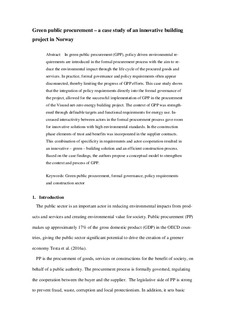| dc.contributor.author | Sparrevik, Magnus | |
| dc.contributor.author | Wangen, Helene Førsund | |
| dc.contributor.author | Fet, Annik Magerholm | |
| dc.contributor.author | De Boer, Luitzen | |
| dc.date.accessioned | 2018-05-02T11:10:59Z | |
| dc.date.available | 2018-05-02T11:10:59Z | |
| dc.date.created | 2018-04-30T11:23:54Z | |
| dc.date.issued | 2018 | |
| dc.identifier.citation | Journal of Cleaner Production. 2018, 188 879-887. | nb_NO |
| dc.identifier.issn | 0959-6526 | |
| dc.identifier.uri | http://hdl.handle.net/11250/2496714 | |
| dc.description.abstract | In green public procurement (GPP), policy driven environmental requirements are introduced in the formal procurement process with the aim to reduce the environmental impact through the life cycle of the procured goods and services. In practice, formal governance and policy requirements often appear disconnected, thereby limiting the progress of GPP efforts. This case study shows that the integration of policy requirements directly into the formal governance of the project, allowed for the successful implementation of GPP in the procurement of the Visund net-zero energy building project. The context of GPP was strengthened through definable targets and functional requirements for energy use. Increased interactivity between actors in the formal procurement process gave room for innovative solutions with high environmental standards. In the construction phase, elements of trust and benefits was incorporated in the supplier contracts. This combination of specificity in requirements and actor-cooperation resulted in an innovative – green – building solution and an efficient construction process. Based on the case findings, the authors propose a conceptual model to strengthen the context and process of GPP. | nb_NO |
| dc.language.iso | eng | nb_NO |
| dc.publisher | Elsevier | nb_NO |
| dc.rights | Attribution-NonCommercial-NoDerivatives 4.0 Internasjonal | * |
| dc.rights.uri | http://creativecommons.org/licenses/by-nc-nd/4.0/deed.no | * |
| dc.title | Green public procurement - A case study of an innovative building project in Norway | nb_NO |
| dc.type | Journal article | nb_NO |
| dc.type | Peer reviewed | nb_NO |
| dc.description.version | acceptedVersion | nb_NO |
| dc.source.pagenumber | 879-887 | nb_NO |
| dc.source.volume | 188 | nb_NO |
| dc.source.journal | Journal of Cleaner Production | nb_NO |
| dc.identifier.doi | https://doi.org/10.1016/j.jclepro.2018.04.048 | |
| dc.identifier.cristin | 1582472 | |
| dc.relation.project | Norges forskningsråd: 236640 | nb_NO |
| dc.description.localcode | © 2018. This is the authors’ accepted and refereed manuscript to the article. Locked until 5.4.2020 due to copyright restrictions. This manuscript version is made available under the CC-BY-NC-ND 4.0 license http://creativecommons.org/licenses/by-nc-nd/4.0/ | nb_NO |
| cristin.unitcode | 194,60,25,0 | |
| cristin.unitcode | 194,12,1,0 | |
| cristin.unitname | Institutt for industriell økonomi og teknologiledelse | |
| cristin.unitname | Rektor og styre | |
| cristin.ispublished | true | |
| cristin.fulltext | postprint | |
| cristin.qualitycode | 2 | |

